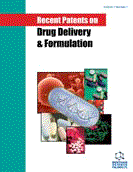Abstract
The global burden of diabetes is estimated to escalate from about 171 million in 2000 to 366 million people in 2030. The routine of diabetes treatment by injection of insulin incurs pain and has been one major factor negating the quality of life of diabetic patients. The possibility of administering insulin via alternative routes such as oral and nasal pathways has been investigated over the years, but with insulin experiencing risks of enzymatic degradation and poor transmucosal absorption. This leads to the rising needs to develop new formulation strategies emphasizing on the assembly of insulin and excipients into a physical structure to maintain the stability and increase the bioavailability of insulin. Chitosan and its derivatives or salts have been widely investigated as functional excipients of delivering insulin via oral, nasal and transdermal routes. The overview of various recent patented strategies on non-injection insulin delivery denotes the significance of chitosan for its mucoadhesive and able to protect the insulin from enzymatic degradation, prolong the retention time of insulin, as well as, open the inter-epithelial tight junction to facilitate systemic insulin transport. The chitosan can be employed to strengthen the physicochemical stability of insulin and multi-particulate matrix. The introduction of chitosan coat or co-formulation of chitosan with cationic gelatin or electrolytes which provide solidified or partially crosslinked structures retain and/or enhance the positive charges of dosage form necessary to induce mucoadhesiveness. The chitosan is modifiable chemically to produce water-soluble low molecular weight polymer which renders insulin able to be processed under mild conditions, and sulphated chitosan which markedly opens the paracellular channels for insulin transport. Combination of chitosan and fatty acid as hydrophobic nanoparticles promotes the insulin absorption via lymphoid tissue. Attainment of optimized formulations with higher levels of pharmacological bioavailability is deemed possible in future through targeted delivery of insulin using chitosan with specific adhesiveness to the intended absorption mucosa.
 46
46














